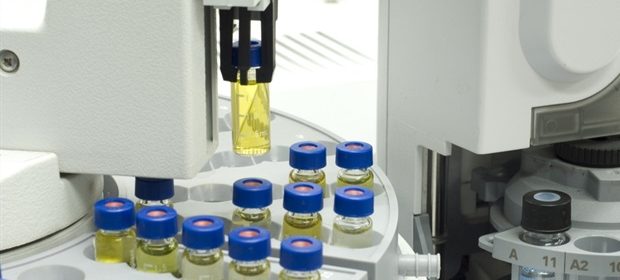Mass Spectrometry Applications

Mass spectrometry represents a powerful technique with a myriad of different applications in biology, chemistry, and physics, but also in clinical medicine and even space exploration. It is used to determine the molecular weight of compounds by separating molecular ions on the basis of their mass and charge.
Various types of mass spectrometry with high specificity (coupled with gas chromatography, liquid chromatography, and matrix-assisted laser desorption / ionization) are being increasingly utilized as tools in the clinical laboratory, but also in different research settings.
Mass Spectrometry in Proteomics
Mass spectrometry has emerged as an indispensable method for the characterization and sequencing of different proteins. The development of two soft ionization techniques capable of ionizing proteins – electrospray ionization and matrix-assisted laser desorption/ionization – revolutionized protein analysis via mass spectrometry.
Two basic approaches are employed in characterizing proteins: “top-down” strategy where intact proteins are ionized by aforementioned soft ionization techniques and then introduced to a mass analyzer, and a second approach where proteins are first enzymatically digested into smaller peptides (by using proteases and other proteolytic agents) and then introduced to the mass analyzer.
Mass spectrometry has gained popularity for protein analysis due to its ability to tackle the intricacies underlying the proteome. The three fundamental applications of the technique in proteomics are determining protein interactions, categorizing protein expression, and locating sites of protein modification.
Mass Spectrometry in Clinical Medicine
Mass spectrometry was used for respiratory gas analysis in hospitals since 1975 as part of a complex system, consisting of respired gas samples from patients undergoing anesthesia. Nevertheless, serious misinterpretations may ensue if certain weaknesses of the method are not appreciated.
Mass spectrometry can also be used for genomics studies with potential implications for clinical medicine. Among the several potential uses of this method, applications are usually concentrated on the characterization of single nucleotide polymorphisms and short tandem repeats.
With the use of metabolomics, mass spectrometry has shown promise in diabetes research as well, as it can discern specific serum profile changes of different metabolites from healthy persons and diabetes mellitus type 2. Furthermore, it has greatly expanded in an area of newborn screening, resulting in a portfolio of multiplexing assays for amino acids, organic acids, fatty acid oxidation, and other congenital errors of metabolism.
Other Applications
There are also space-related applications of mass spectrometry, two important ones being observing air quality of manned space mission and examining the composition of planetary atmospheres. The success of its use in planetary missions can be attributed to space vacuum that can be used to decrease resource demands.
Due to its speed and sensitivity, mass spectrometry has also played a pivotal role in many phases of drug discovery. Drug reaction optimization, structural analysis of library products, and the evaluation of library compound quality are just few examples of how this technique can be employed.
Mass spectrometry is also becoming increasingly used in geologic research for petroleum composition measurement and carbon dating. The technique can also be used to test water quality or potential food contamination.
In short, mass spectrometry is becoming very prominent in all sorts of clinical and other research endeavors. Thus a basic grasp of the technology is necessary to understand all the possible productive interactions.
Sources
- http://www.ncbi.nlm.nih.gov/pmc/articles/PMC2642903/
- http://www.chem.umass.edu/~vachet/Course/NatRevDD-2p140.pdf
- http://onlinelibrary.wiley.com/doi/10.1016/S0014-5793(00)01773-7/pdf
- http://ntrs.nasa.gov/archive/nasa/casi.ntrs.nasa.gov/20100039433.pdf
- www.veterinaryworld.org/…/Mass%20spectrometry%20-%20A%20review.pdf
- www.intechopen.com/…/a-short-overview-of-the-components-in-mass-spectrometry-instrumentation-for-proteomics-analyses
- Watson JT, Sparkamn OD. Introduction to Mass Spectrometry: Instrumentation, Applications, and Strategies for Data Interpretation. Fourth Edition. John Wiley & Sons Ltd, West Sussex, England; 2013.
Further Reading
- All Mass Spectrometry Content
- What is Mass Spectrometry?
- Using Mass Spectrometry for Protein Complex Analysis
- Coupling and Ionization in Miniature Mass Spectrometry
- Life Science Applications of the Top-Down Approach
Last Updated: Feb 26, 2019

Written by
Dr. Tomislav Meštrović
Dr. Tomislav Meštrović is a medical doctor (MD) with a Ph.D. in biomedical and health sciences, specialist in the field of clinical microbiology, and an Assistant Professor at Croatia's youngest university – University North. In addition to his interest in clinical, research and lecturing activities, his immense passion for medical writing and scientific communication goes back to his student days. He enjoys contributing back to the community. In his spare time, Tomislav is a movie buff and an avid traveler.
Source: Read Full Article